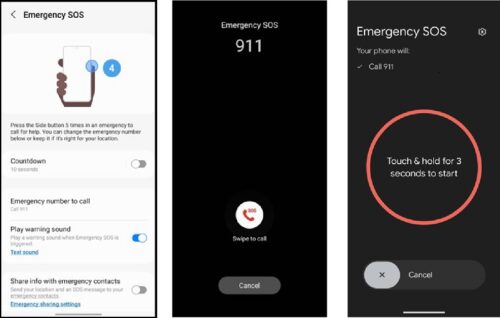6.29.23 – NENA
NENA staff has been working with Google and Original Equipment Manufacturers (OEMs) regarding a recent and large uptick in accidental calls caused by changes to default behavior in some devices for the Emergency SOS feature in Android. This feature is activated by rapidly pressing the power button 5 times. With recent changes in settings included in recent updates to some Android OEMs, the Emergency SOS feature has initiated a large volume of “accidental” 9-1-1 calls. NENA has data that PSAPs report up to a 30% increase in call volumes in May and June, most of them attributed to this feature change.
Android Operating System (OS) software from both Google and OEMs have introduced updates to address the issue. For multiple major OEMs, the updates have already been pushed to the public and installed on many devices. It will take some time for updates to reach a critical mass of handsets, and for users to install them, for the issue to be completely addressed. This may take weeks to months. NENA advises all Android users to update their OS to the latest version.
The following is a guide to the Emergency SOS feature as tested on a Samsung Galaxy S22 updated on June 26, 2023. This guide reflects NENA’s internal findings only, and is not meant to nor shall it be inferred to be associated with or to endorse either Google or Samsung.
With the update, the Emergency SOS feature cannot be entirely disabled. However, with recent system updates, most Android devices will now have the “Countdown” feature by default set to OFF (pictured below, left). In this mode pressing the power button 5 times will prompt the user to dial 9-1-1 but will not do so automatically. The device will time out after 5-10 seconds of waiting if the user does not interact with it.

After the timeout, if the user does not interact with the phone, it will return to the screen the user was previously using (for example the lock screen, or whichever app was being used prior to initiating Emergency SOS if the phone is not locked). With the Emergency SOS prompt, the user will be prompted to call 9-1-1 but the phone will not call 9-1-1 automatically. The interface may look different depending on the device (pictured above, center, is a Samsung Galaxy S22 and pictured above, right, is a Google Pixel 6).
 If the Countdown feature is enabled, it will count down from the configured number (pictured left is the test device default of 10 seconds). Once the count reaches 0, it will automatically dial 9-1-1.
If the Countdown feature is enabled, it will count down from the configured number (pictured left is the test device default of 10 seconds). Once the count reaches 0, it will automatically dial 9-1-1.
If the user prefers this functionality, they must choose to enable it in their settings. If the countdown feature turned ON, the phone can accidentally dial 9-1-1 if the user’s power button is pressed 5 times and the user does not interact with the phone. For example, this can happen when the power button is cycled rapidly without intending to call for help, such as if young child is playing with the device.
If the user does not click “cancel” during the countdown, the phone will call 9-1-1, 112, 999 or whichever primary emergency number is appropriate for their locality or country. The user may also set a specific default emergency number as well as emergency contacts if they prefer.
As Android phones are updated, these default feature changes should provide relief from the rash of unintended emergency calls internationally that have been largely attributed to this feature through May and June.
